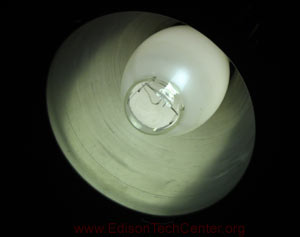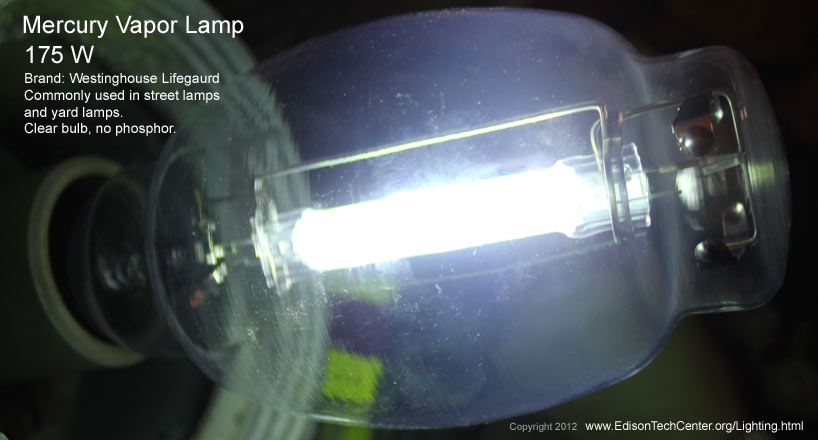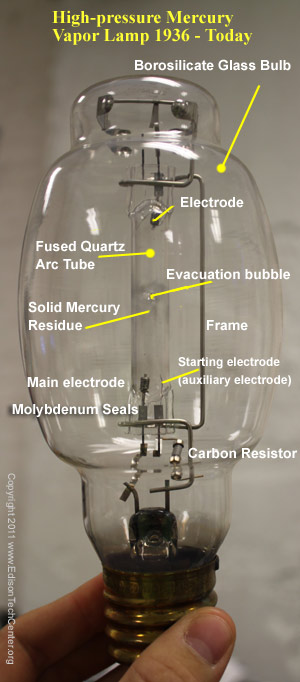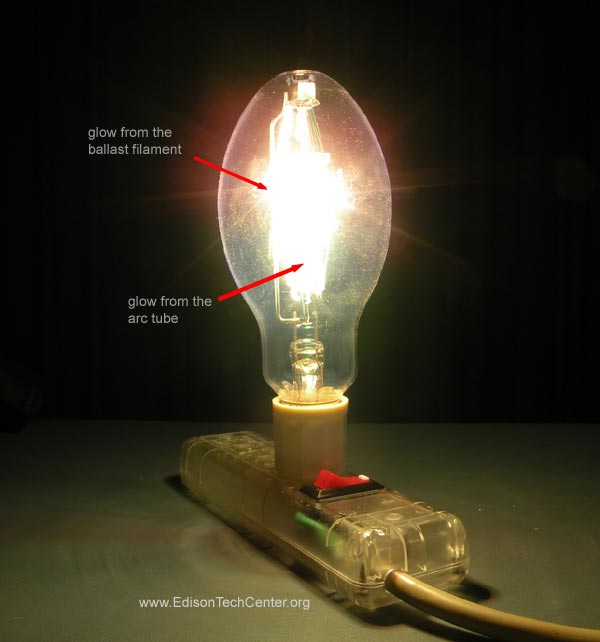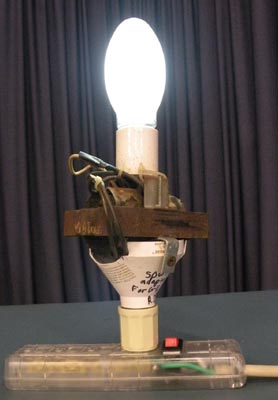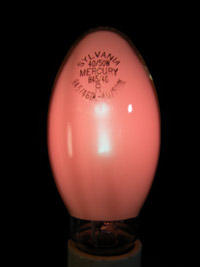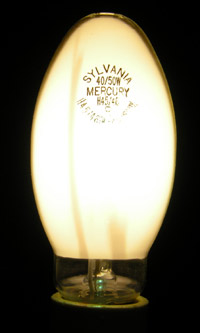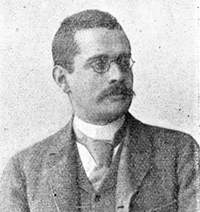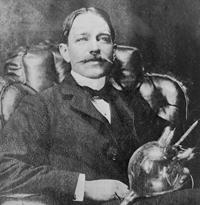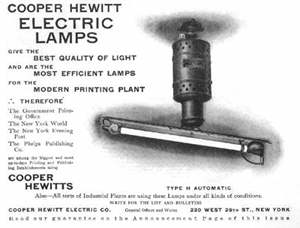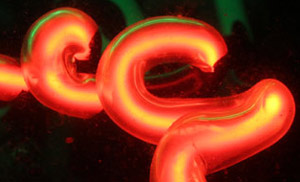Mercury Vapor Lamps

The first HID lamp
History (1901 - Today)
All credits and sources are located at the bottom of each lighting page
Introduction & Statistics
Introduction:
The mercury vapor lamp is a high intensity discharge lamp. It uses an arc through vaporized mercury in a high pressure tube to create very bright light directly from it's own arc. This is different from fluorescents which use the mercury vapor arc to create a weaker light that mainly creates UV light to excite the phosphors. The "Merc" as it is known has been a workhorse for society; lighting streets, factories and large areas for over 100 years.
Advantages:
- Good efficiency (lamps after 1980s have a high lumen per watt rating)
- Color rendering is better than that of high pressure sodium street lights
- Some lamps last far longer than the 24000 hour mark, sometimes 40 yearsDisadvantages:
- Like many lamps it contains traces of mercury which must be disposed of properly
- HPS streetlights have a better lumen per watt rating
- Human skin looks green under the light, it is poor for color film/photography
-Warm up time required to start the lamp
Statistics
*CRI 20 (clear bulb) 60 (phosphor coated)
*Color Temperature - 6800 K (clear bulb)
*Lumens per watt: 30-60
*Lamp life: 24,000 - 175,000 hours
*Available in 40-1000 WCommon uses: large areas like parks, street lighting, high ceiling buildings, gyms. Low pressure lamps with a quartz envelope are used for germicidal purposes since they allow UV light to pass.
Left: Mercury Vapor with phosphor for improved color
1. How it works 2. Inventors and Developments
Video:
1. How it Works
Above is a "Lifegaurd" brand lamp by Westinghouse, it needs a ballast to run.
UV rays are produced, but blocked by the borosilicate glass.There are several versions of the lamp but the basic principle is the same.
Low Pressure:
The first mercury vapor lamps were in a lower pressure tube. One would tip the lamp, and electrical contacts on each side of the lamp would send electricity through a liquid mercury which started the lamp. After that the lamp would heat fast and mercury became a vapor. The light would intensify as the arc grew stronger in the tube.
High Pressure:
Lamps of today are high pressure lamps with a fused quartz inner discharge tube. The high pressure helps increase efficiency and this was developed in 1936, 35 years after the low pressure lamps came out.
This lamp start with a small arc between the starting electrode and the main electrode. This arc goes through argon gas which easily strikes, even in cold weather. This little arc heats the tube, and over several minutes the tube gets hot enough to vaporize the solid mercury stuck to the sides. The mercury vaporized creates a strong light between the two main electrodes. (see graphic to the left)
To prevent the arc from infinitely getting stronger a ballast limits the current. Some lamps are "Self Ballasted", they use an incandescent filament to act as a resistor, limiting current. Home lighting fixtures usually use the self-ballasted type where as the more expensive but more efficient ballasted lamps are found in large fixtures for municipal lighting.
The photo below shows a self-ballasted lamp, notice the tungsten filament.

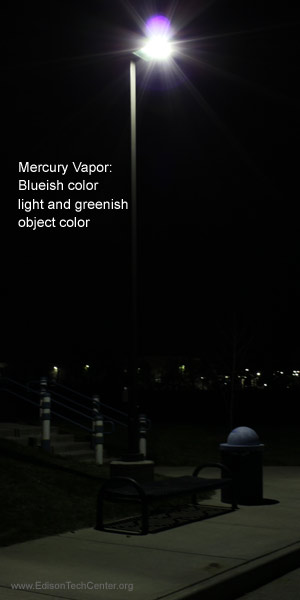 |
|
A Mercury Vapor with a transformer (ballast) build into the base.
The bulb at left is just warming up, the bulb at right is after a few minutes of warming. This bulb has phosphor to help make the light more of a true white color. It can take several minutes to warm up.
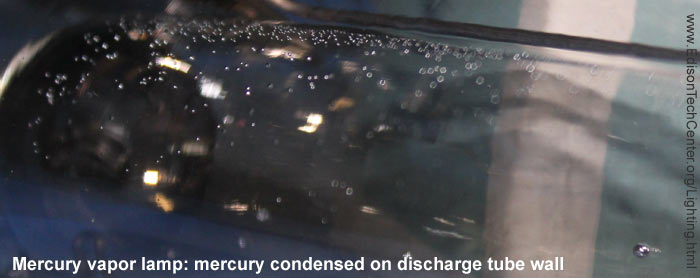
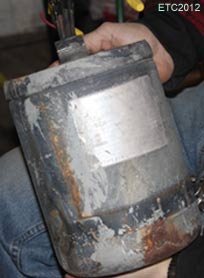
Left:
small amounts of mercury visible on a large discharge tube.\
Right: older heavy ballast for a standard ceiling mounted merc
fixture
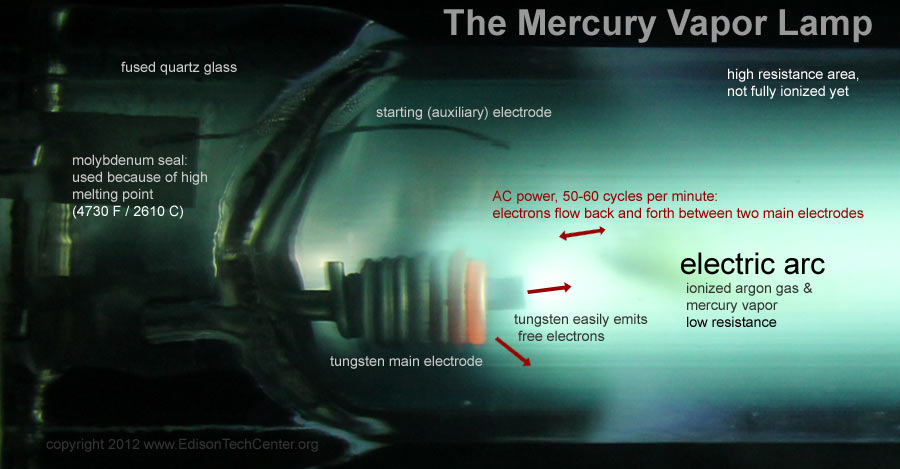
1835 - Tested mercury vapor arcs in air at common atmosphere
Charles Wheatstone (London) worked with arcs through mercury during this tests in spectropy. He would create an arc through a metal, then observe what colors it produced when a prism separated the light into it's individual frequencies.1860 - Developed a rudimentary mercury vapor lamp
John Thomas Way (London) Developed a mercury vapor lamp. He tested them on the Hammersmith Bridge in London.
1892 - Developed an experimental mercury vapor lamp
Leo Arons, (University of Berlin). His lamp worked fine but had a green blue color that was not acceptable to most people.
1901 - The First Commercial Mercury Vapor Lamp
Peter Cooper Hewitt (New York City) had a history of innovations in other fields, and when he set about on the project of the mercury vapor lamp in 1898 it only took 3 years to develop the first reliable lamp with a acceptable color of light. His work was a commercial success and eventually his company and patents were bought out by General Electric in 1913.
An early mercury vapor lamp. One would tip the light to get it to start. These early low pressure lamps used a lot of mercury, today's lamps use a tiny amount of mercury. Right around 1900 the mercury arc rectifier was developed, this luminous device was very important for power conversion. NYC subways were still using original mercury arc rectifiers to convert AC to DC power up until the end of the 20th century. (Read more about the Mercury Arc Rectifier)
Later Cooper Hewitt mercury vapor tubes and historic fixture
1906 - Higher pressure mercury vapor light in a fuzed quartz tube is developed
Kuch & Retschinsky (Siemens, Munich)1936 - The modern high-pressure mercury vapor lamp is developed, type MB
Philips (Nederlands) No individual names are availableFurther reading: www.lamptech.co.uk/Documents/M Timeline.htm
Lamps are presented in the order of chronological development
|
Previous: Neon Lamps 1898 |
Next: Sodium Lamps 1920 |
 |
|
Arc
- Incandescent - Nernst
- Neon - Mercury
Vapor - Sodium Lamp - Fluorescent
- Halogen - EL
- LED - MH
- Induction
|
COMMENTS?
Give us feedback on this and other pages using our Facebook
Page
Written
by M.Whelan with additional research by Rick DeLair
Please contact us if you are a historian and wish to correct or improve
this document.
Sources:
"The General Electric
"A History of Electric Light and Power" by B. Bowers
Photo/Video
use:
Commercial entities must pay for use of photos/graphics/videos in their
web pages/videos/publications
No one commercial or public is allow to alter Edison Tech Center photos/graphics/videos.
Educational Use: Students and teachers may use photos and videos
for school. Graphics and photos must retain the Edison Tech Center watermark
or captions and remain unmanipulated except for sizing.
Permissions
- Videos: We do not email, FTP, or send videos/graphics to anyone
except in DVD form. Payment is needed for this service. See our donate
page for pricing, and our catalogue
for a listing of videos on DVD.
Professional video production companies may get videos in data form with
signed license agreements and payment at commercial rates.

